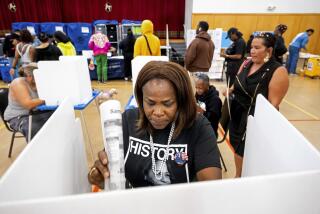Caltech, MIT Seek to Build a Better Ballot
- Share via
Caltech and the Massachusetts Institute of Technology announced Thursday that they will join their brainpower to figure out how to update the nation’s creaky voting apparatus and develop a better way to cast ballots.
“It is preposterous that a lack of technology would bring this democracy to its knees,” said Caltech President David Baltimore. “It is embarrassing to America. . . . So we have a responsibility to make sure it never happens again.”
The goal is to produce new voting machines that are reliable, easy to use and tamper-resistant to minimize the prospect of manipulation or fraud.
“We hope to find a system that is idiot-proof,” Baltimore said.
The six-month first phase of the study, funded by an anticipated $250,000 grant from the Carnegie Corp. of New York, will team political and computer scientists with economists, electrical engineers and cognitive scientists from the two campuses to evaluate existing technology, including voting via the Internet and the touch-screen voting machines used this November in Riverside County.
The team of professors also will estimate the cost--and potential savings--involved in upgrading and standardizing the patchwork quilt of ballot formats used across the country.
“A nation that can send a man to the moon and put an ATM on every corner has no excuses why it cannot put in a reliable voting system,” said MIT President Charles M. Vest.
The prospect of recommendations from academic experts was warmly received by politicians leading bipartisan efforts to reform voting methods.
“The more ideas you have on the table, the better off we are,” said California Secretary of State Bill Jones, a Republican. “They are probably more intelligent than any of us, so I’m looking forward to their input.”
Sen. Charles E. Schumer (D-N.Y.), who is pushing the Federal Election Commission to study voting alternatives, welcomed any advances in technology.
“That’s exactly what we’re looking for,” Schumer said through a spokesman. “If two of the nation’s most prestigious institutions could develop a technology that doesn’t exist, we’d take that right to the FEC.”
Baltimore decided that election officials could use academic help when he watched in horror as the presidential campaigns bickered over uncounted or miscounted ballots in Florida.
“It was about a week into the process,” he said. “This was a national disaster that technology could--and should--prevent from happening again.”
So he reached out to Carnegie for money and to MIT for academic assistance. Baltimore, a former MIT professor, won a Nobel Prize there for his work on viruses in 1975. He hopes that findings from the nation’s two premier technical universities will carry more weight than if they were from one institution alone.
The team has been given six months to figure out exactly what the nation needs to conduct far more reliable elections.
Team members already agree that optical scanners and punch-card ballots--the two most widely used technologies--are unacceptably unreliable. As was seen in Florida, punch-card ballots undercounted, or failed to correctly record a choice of candidate, in 15 of every 1,000 ballots. Optical scanners had similar, though less severe, problems.
The professors plan to check other countries to see if any technology is up to their challenge. If there is none, they hope to design their own, teaming up electrical engineers and computer scientists with MIT’s Media Lab, which explores the human interface with technology.
Thomas Paltry, a Caltech political scientist and economist, said any wholesale overhaul of the nation’s voting machines will cost billions of dollars. One estimate puts that figure at $9 billion.
But he said many states use 19th century machines for which spare parts cannot be found and which need to be upgraded anyway. Furthermore, any new costs would be offset somewhat by the savings of not having to maintain decrepit machines.
High-tech solutions, however, will probably need more technical support than current systems, both at elections offices and at the polls--which are often run cheaply by elderly volunteers.
Nicholas Negroponte, chairman of the MIT Media Lab, said any new voting machine needs to give the voter feedback, preferably a record of how the voter cast his or her ballot. Such voting records could also be stored in a secure place, where voters could return to inspect them.
Negroponte likened use of today’s antiquated voting machines to pushing the button in an elevator. If the button fails to light up, the person will push it again, and again, thinking the elevator is malfunctioning.
Similar confusion has caused some voters to double-punch ballots. The goal of any new system would be to reduce confusion and human error that is magnified by outdated technology.
One hopeful note is that overall, technology is getting simpler to use. Most people can operate remote controls for TVs and VCRs and get cash out of automated teller machines.
So Baltimore and his colleagues believe they can come up with a secure voting system that inspires confidence in the electorate.
“If you are willing to entrust your money to an ATM,” Baltimore said, “that seems to be a good surrogate to entrusting your vote to an ATM.”
More to Read
Sign up for Essential California
The most important California stories and recommendations in your inbox every morning.
You may occasionally receive promotional content from the Los Angeles Times.













